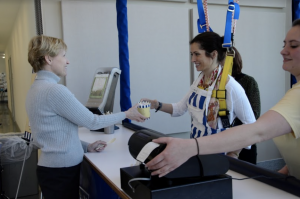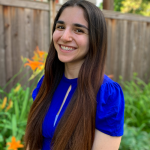Technology for a more Inclusive world
When you wake up in the morning, you may check your phone for a few minutes, get out of bed, walk to the bathroom, brush your teeth, walk back to your room, change clothes, go downstairs for breakfast and head out the door. You most likely do these things without real thought and care about the process. Well, for many people with a disability, these simple tasks must be much more planned out and with special assistance from technology.
With one in four adults living with a disability in the U.S., it’s an issue we should all care about.
Whether it be in mobility, sight or hearing, inclusive technology can be life-changing for those who receive it. Take Soundscape for example, a phone application that enables low-vision individuals to have independence during everyday tasks. Using a stereo headset, it allows the user to hear the landmarks around them in 3D sound. By creating a sound map around your head, Soundscape allows the user to feel more comfortable and confident exploring the world alone by adding realism to directions.

This kind of technology is not just for the vision impaired. Walking around a new college campus can be confusing; Soundscape’s synthesized binaural audio is an inclusive technology that can aid anyone in reaching their destination.
What about if you love to play video games but have limited mobility? Well, the Xbox Adaptive Controller was specifically designed to give a custom controller experience to those who needed a more accessible setup. With large programmable buttons and external accessories, this controller helps make gaming an activity anybody can enjoy.

In my current communications internship at UDairy, University of Delaware’s on-campus creamery, I have been impressed with their strides in inclusive technology.
In 2014, the UDairy Creamery partnered with the College of Health Sciences to open the Go Baby Go Cafe. Cole Galloway, a professor and researcher in the department of physical therapy, created the tech originally for Go Baby Go!, which uses repurposed robotic toy cars to help children who have trouble walking and crawling be able to play. By adapting the technology into a harness system for adults with limited mobility (from brain injuries), individuals can rehabilitate in a setting that closely resembles a real-life working scenario. Besides offering a vocational rehab to those in need, the cafe provides delicious snacks and ice cream on UD’s campus.

A photo of a woman using the harness system at the Go Baby Go Cafe, handing a female customer a pint of ice cream.
As an intern, I’ve also seen the generous amount of effort that the communications team puts into making UDairy’s social media as accessible as possible on a day-to-day basis. I create graphics that aren’t too wordy so that vision-impaired individuals’ screen readers can identify the content; this is where alt text comes in! You can add alt text to your images and infographics that clearly describe what’s in the picture, which screen readers (and even search engines like Google) can then read out loud to users.
There are 7.6M people with visual impairments in the U.S. alone, so setting an example and advocating for disability is crucial to creating an environment that is welcoming and celebrates diversity.
Although there is still a long way to go, all three of these examples are ways in which inclusive technology is becoming more and more popular in the world around us. By creating diversity, equity and inclusion initiatives and products, we are creating a more connected world and thereby becoming a better world.
 Lia Hyman is a junior at the University of Delaware studying communication and international business studies. She currently sits on PRSSA’s PRoud Council and PRSSA-UD’s executive board as the Diversity Director. Lia works as the Communications intern for UDairy Creamery and hopes to one day land her first agency position. In her free time, she weightlifts, drinks too much coffee, practices Italian, lights incense, and travels all over the world.
Lia Hyman is a junior at the University of Delaware studying communication and international business studies. She currently sits on PRSSA’s PRoud Council and PRSSA-UD’s executive board as the Diversity Director. Lia works as the Communications intern for UDairy Creamery and hopes to one day land her first agency position. In her free time, she weightlifts, drinks too much coffee, practices Italian, lights incense, and travels all over the world.
